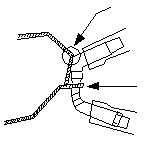Poor Weld Accessibility
Definition
Poor weld accessibility is inadequate gun access to the proper weld spot location on the part or welded flange, touching only at the interface between welded part and electrode without interference with the part or fixture at any other area.
Description
The gun electrode should not contact the fixturing nor the workpiece, except at the electrode contact diameter. The electrode tip should not touch at the welded panel's bend radius nor the edge. The fixturing and locating features should be adjusted to allow for proper location of the weld flange with respect to the weld gun access.
Detection
Poor weld accessibility could produce the following results:
- Stuck Weld
- Undersized Weld
- Mislocated/Edge Weld
- Sheet Metal Distortion
- Poor Class A Appearance
- Poor weld accessibility could result in part damage from gun interference

Part/Gun Interference
Significance
Quality, Workplace Issues, Cost, Downtime, Maintenance, Throughput (cycle time; PPH), are all potentially affected by this condition. Special considerations are noted below:
Cost: Cost is impacted when repairs to equipment are required because of deterioration due to stress from poor weld accessibility. Closed-out (inaccessible) welds necessitate increased teardowns and will therefore raise operating cost. Consider reach-in and spot location, at the design stage, to avoid large throat area requirements for weld guns; thus, effecting cost and performance.
Subordinate Causes
- Improper spot location
- Poor metal fit-up
- Improper gun/shank/electrode
- Incorrect tip alignment
- Part bend radius interference
- Improper flange width
- Inadequate electrode to workpiece clearance

